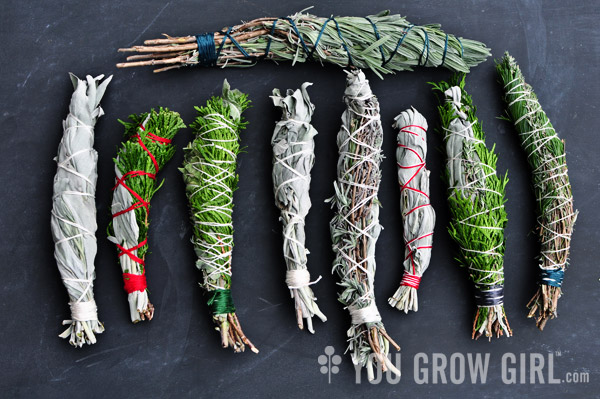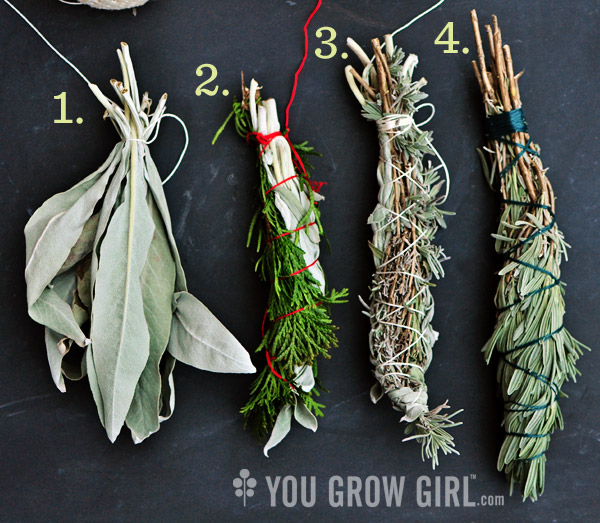
Herbal bundles are tightly bound rolls of dried woody, resinous herbs, that are slowly burned as a way to purify and cleanse the air. The roots of burning an herbal bundle, or smudging, is in indigenous purification rites and ceremony that span the world globally. It is not a homogeneous practice, and since I am not a member of an indigenous group, I will not be making any claims to the practice as ritual, nor will I be using the associated terminology.
If you have a garden, chances are good that you have enough ingredients to make at least one bundle. The most popular herbs known to be used in North American Native smudging ceremonies are white sage (Salvia apiana), Cedar (Thuja), Sweetgrass (Hierochloe odorata), sagebrush (Artemisia californica), and mugwort (Artemisia vulgaris). However, these preferences are closely tied to specific groups and their use is governed by choices I am not knowledgable about. What’s more, many of these plants have been over-harvested in wild areas due to popular culture interest in co-opting indigenous practices. Instead, I suggest experimenting with other woody, resinous herbs that are appropriate to your climate and readily available in your own garden. Another option would be to choose plants that resonate with your own cultural traditions or have personal meaning to you. Common garden herbs worth trying include:
Thyme (Thymus vulgaris), lavender (Lavandula), yarrow (Achillea millefolium), juniper, pine, mullein (Verbascum thapsus), rosemary (Salvia rosmarinus), lemon balm (Melissa officinalis), mint (Mentha), Bee Balm (Monarda), and catnip (Nepeta cataria) to name a few.

From Left to Right: white sage; cedar and white sage; cedar, white sage, and lavender; white sage; lavender and white sage; white sage bound with two different threads; cedar, white sage, and a very woody and resinous, heady orange-scented thyme (Thymus vulgaris ‘Orange Balsam’); pine and ‘Orange Balsam’ thyme. Top: Lavender (Lavandula angustifolia ‘Hidcote’). I used two varieties of lavender here, but I can’t recall the name of the other. All of these plants were grown by me and harvested from my garden
On Growing White Sage (Salvia apiana) in a Cold Climate: The other day I harvested a large white sage (Salvia apiana) plant that I have been growing in my garden’s sandy, dry bed. This plant is on the cusp of hardy in my area (I am in zone 6bish and the plant’s hardiness begins at around zone 6), but this year I decided to free it from life in a pot to see how it did in the ground. Unlike the specimens I saw growing wild in Northern Mexico, my plant grew gigantic leaves, most likely the result of the wet season we’ve had. Still, it has a very strong, medicinal odour typical of the plant. I’ve left enough in that soil that should we have a mild winter, it just might live through to the next season. [Update: Several seasons later and I have never been able to overwinter Salvia apiana successfully in the ground. Since then I have had better luck potting it up and overwintering on my sooth-facing, unheated, covered porch. Here is does experience some deeply freezing temperatures, but is never too wet, which has been a problem in the past. If you plan to overwinter yours in a similar climate, I suggest locating it to a spot where the soil can be kept on the dry side.
When Choosing and Harvesting Herbs: Please be careful as some herbs — even the culinary types — don’t lend themselves well to burning and can be toxic or set off dangerous allergic or asthmatic reactions in some people. I have often seen common garden sage (Salvia officinalis) used to make bundles. This is not a safe herb to burn despite its safety in a host of other applications. When in doubt, burn a very small amount of a plant outdoors first, in order to test the smell and indicate whether you might have a problem with it. I also have a dangerously strong negative reaction to yarrow, so again, please use caution with this herb.
Harvest herbs on a sunny and dry day. Moist herbs will grow mouldy inside the bundle where there is very little air. Pick herbs on the day you plan to use them; resinous herbs tend to dry very quickly and are nearly impossible to wrap tightly once dry. A final note that when harvesting from the wild: don’t do it. If you do, please stick to plants that are invasive. Stay away from native perennial herbs as they are being over-harvested.
Choosing String: Remember that anything you use to bind the bundle will eventually burn so it is advisable to use natural materials that will not give off a toxic fume or compete with the smudge smells. I try to use as little string as possible to avoid creating a strong burning string smell. I suggest using thin, organic cotton string when you can. Embroidery floss separated into 4 threads (they typically come as 6 threads) is strong enough. Use a single color of string or experiment by mixing colors. I like using a simple color to bind and a subtle colour that compliments the foliage to make the handle.
How to Bind an Herbal Bundle

The key to making a successful herbal bundle is in binding tightly. I liken it to cigar making in that a tight bundle of leaves burns more slowly. I also find that the plant materials shrink as they dry and a loosely tied bundle is more likely to lose bits and pieces along the way or fall apart completely. With that in mind, grasp plants firmly and give the string a tight yank each time you turn or tie.
- Step 1. Clip herbs into similarly sized lengths. Don’t skimp out — thick bundles smoulder slowly and are better looking. Pluck off any diseased or ugly leaves. Arrange the stems into a bundle and tie a tight knot around the stem end to secure. Wrap the string around the stems a few more times and then tie another knot to secure.
- Step 2. Grasp the bundle with one hand and begin winding the string on an angle up to the tip of the bundle. Try to use as little string as possible and pull tightly as you go. I find that large-leaved herbs don’t need much binding, while very thin leaved herbs, especially conifers require more winding to prevent the leaves from falling out. You can leave the foliage loose at the end or fold under to keep everything tight.
- Step 3. Turn the bundle around and begin winding down back to the start, creating a criss cross pattern overtop the first strings.
- Step 4. You can choose now to either go back up and down again, retracing the path you took with another layer of string, or you can bind off and complete. I find that the pass tends to create a tighter bundle and is a good way to pull in and secure any pieces that got away the first time around. Wind plenty of string around the base of the bundle to create a handle. You can use as much string as you want here since this part will not burn. Tie off and clip any loose strings to create a neat and finished look.
- Step 5. Set the bundles aside somewhere dry and dark where there is good air circulation. You can hang them using thin wires or Holiday tree ornament hooks wedged underneath the handles. You can also lay them out flat to dry, but here I suggest setting them on top of a screen or very loosely woven basket that is raised up off of any solid surfaces so that air can flow underneath and around the bundles.
Wait until your bundles are completely dry (this usually takes a few weeks at least) before burning them.
THAT is a super cool idea. I never heard of this. I have many of the plants on your list of possibilities. Thanks for the inspiration.
Similar warning would apply for california bay leaves. I tried slow simmering them over the stove in a vessel of water and it gave me a splitting headache.
Good to know. Is that Umbellularia californica? Might be the camphor(ishness).
A few years ago I made my first smudge stick and was a bit happy with it. After reading your post, I will try it again. My first attempt did not burn slowly…….error in the binding. Thank you for such informative explanation. I always enjoy the process of Smudging. When I was growing up in the Caribbean, we usually burn dried leaves in an open clay pot.
Smouldering in an open pan is common with North American Native communities as well, but not really practical inside homes. Do you recall which leaves were used? I am curious. There is a non-culinary lemongrass that grows like crazy in Dominica. I bet it would work. I should have thought when I was there.
What a great idea, and thank you for the clear instructions.
I bet those smell nice. Here in Southern Alberta, the First Nations use Sweet Grass for smudging. I’m not sure if its something that could be grown in a garden…?
Sweetgrass is what I see most often for sale in health food stores, etc around here. No reason why you can’t grow it in a garden.
@Gayla, I think it was Umbellularia californica. It has a nice sweet smell when you crush the leaves a bit. I’ve used it in the past as a car air-freshner by combining it with rosemary leaves and leaving it a pouch. On hot sunny days, the car would then smell nice and fresh.
But using it as a room freshener, by simmering on an open stove was a bad idea. Luckily I realized very soon (esp. after taking a long deep breath of the wispy fumes) that it was actually causing the headache :). Googling about it later, revealed that the plant is also colloquially known as the headache plant.
That actually gave me the idea of trying to use it as an air-freshner,
I grew white sage over this summer with the sole intent of making these. But, unfortunately, the plants ended up dying. I absolutely love this idea and didn’t even think of using the other plants you mentioned. I’ll have to try growing those as well starting next spring.
Quick question: Do you burn the string along with the smudge stick? I always pull it away as it gets close, but I’m not sure if I need to.
I burn the string, which is why i suggest using the thinnest string possible, wrapping only as much as necessary to hold the plant material in, and using cotton rather than synthetic.